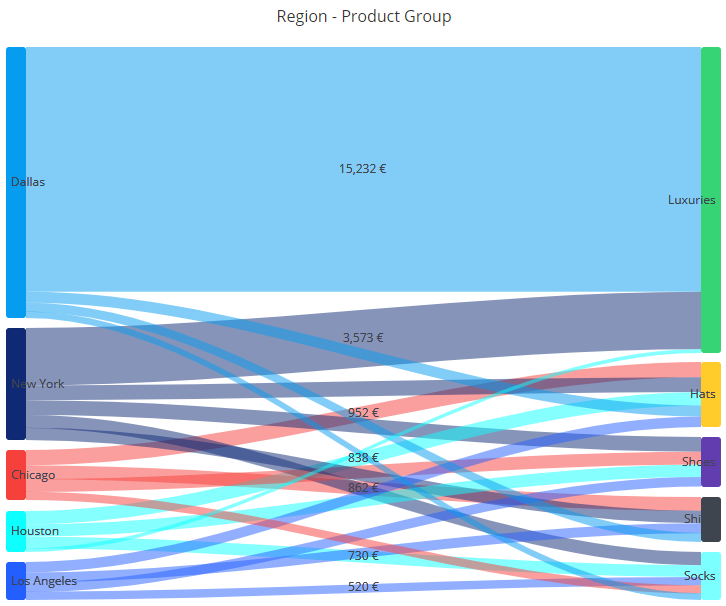Sankey Chart: Difference between revisions
(Created page with "Sankey chart visualizes volumes between values of two features. It is also suitable for visualizing flow from a feature to another. To use sankey, following mappings need to be defined * '''Start''': The feature on the left side of the sankey. Usually this is textual data, but any data types can be used here. * '''End''': The feature on the right side of the sankey. Usually this is textual data, but any data types can be used here. * '''Weight''': The weight determines t...") |
No edit summary |
||
| Line 5: | Line 5: | ||
By default the first dimension is the start mapping, the second dimension is the end mapping and the first measure is the weight. If you need to change the mappings, they can be found in the measure, dimension or column settings dialog. | By default the first dimension is the start mapping, the second dimension is the end mapping and the first measure is the weight. If you need to change the mappings, they can be found in the measure, dimension or column settings dialog. | ||
Sorting can be used to set the order of start and end items vertically in the sankey left and right pilars. If sorting items by the dimension mapped as start or end, the order is set alphabetically by the start or end items. If sorting items by the weight, the highest or lowest weight flows are on top. | |||
Creating filters is also possible when clicking the flows in the sankey. The created filter is based on the dimensions/columns that are mapped as start and end. Note that creating filters is not always possible, as there needs to be a meaningful filter rule available that represents the dimension/column. | Creating filters is also possible when clicking the flows in the sankey. The created filter is based on the dimensions/columns that are mapped as start and end. Note that creating filters is not always possible, as there needs to be a meaningful filter rule available that represents the dimension/column. | ||
Sankey is able to visualize backward flows (i.e., starting point is right of the ending point), but sankey may not be the best visualization for that. If there are backward flows, you can see the dependency wheel or flowchart. | |||
Use cases for sankey: | |||
* Visualize how two different case or event attributes are linked together. The weight can be the case/event count or numerical case/event attribute, such as cost if it's available. | |||
* Visualize transition between two event types in the process flow. | |||
Example: | |||
[[File:Sankey.png]] | |||
Revision as of 22:35, 27 April 2023
Sankey chart visualizes volumes between values of two features. It is also suitable for visualizing flow from a feature to another. To use sankey, following mappings need to be defined
- Start: The feature on the left side of the sankey. Usually this is textual data, but any data types can be used here.
- End: The feature on the right side of the sankey. Usually this is textual data, but any data types can be used here.
- Weight: The weight determines the thickness of the flow drawn between the left and right value in the sankey.
By default the first dimension is the start mapping, the second dimension is the end mapping and the first measure is the weight. If you need to change the mappings, they can be found in the measure, dimension or column settings dialog.
Sorting can be used to set the order of start and end items vertically in the sankey left and right pilars. If sorting items by the dimension mapped as start or end, the order is set alphabetically by the start or end items. If sorting items by the weight, the highest or lowest weight flows are on top.
Creating filters is also possible when clicking the flows in the sankey. The created filter is based on the dimensions/columns that are mapped as start and end. Note that creating filters is not always possible, as there needs to be a meaningful filter rule available that represents the dimension/column.
Sankey is able to visualize backward flows (i.e., starting point is right of the ending point), but sankey may not be the best visualization for that. If there are backward flows, you can see the dependency wheel or flowchart.
Use cases for sankey:
- Visualize how two different case or event attributes are linked together. The weight can be the case/event count or numerical case/event attribute, such as cost if it's available.
- Visualize transition between two event types in the process flow.
Example:
